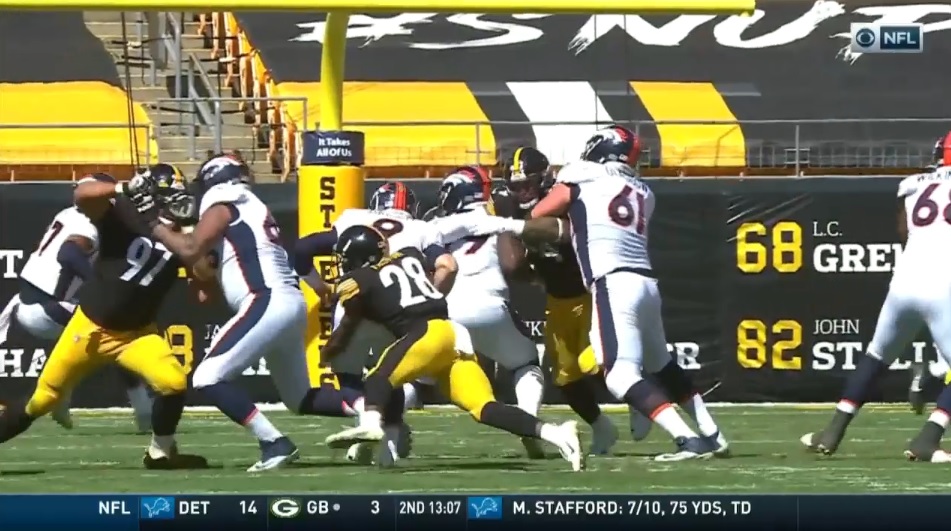The Pittsburgh Steelers recorded seven sacks in Sunday’s win over the Denver Broncos. Several of those came from conventional sources. TJ Watt had 2.5, Cam Heyward chipped in a half-sack, and Bud Dupree knocked a ball out of Drew Lock’s hand (knocking Lock out in the process).
But the Steelers add another layer. They’re more than capable of getting home with just four but they’re not afraid to turn up the heat either. As Mike Tomlin bluntly said yesterday, they’re not afraid of bringing anyone. Off-ball linebackers, corners, safeties, they all join the sack party.
Pittsburgh had two more from that group yesterday. One from Mike Hilton, his second of the year, and a game-clincher from Terrell Edmunds. Each time, the DB came unblocked, a free path to the quarterback, and a gimmie sack. How do the Steelers have this success? Offenses know they’re bringing pressure. At this point, it’s not unexpected.
It all comes down the scheme. Stress protection schemes and be unabashedly aggressive. Let’s check the tape. The first is Mike Hilton’s sack. Steelers bring a five man pressure. Hilton blitzes to the field side, away from the running back.
The blitz is designed to get Hilton freed up. Everyone else slants down a gap, including LOLB Alex Highsmith. Highsmith does not have a two-way go on this rush. A two-way go is when a pass rusher has the ability to rush inside or outside, whatever path works best against the linemen’s pass set. Here’s a two-way go as illustrated in Dick LeBeau’s 2002 Bengals’ playbook.
A player without a two-way go has a specific rush lane. Highsmith’s job is to slant down into the B gap. That occupies the RT and gives Hilton a sharper path to the quarterback. If Highsmith were to rush wide here, he may get in Hilton’s way or force him wider up the arc. There are blitz schemes designed for the LOLB to work wide and the NCB to come underneath him but that isn’t the case here.
With 2i Tyson Alualu slanting into the A gap and Highsmith into the B, the Broncos’ o-line sliding away and the RB releasing into a route, there’s no one to pick Hilton up. Free lane to the QB and Hilton finishes it with a sack.
Fast forward to the end of the game. 4th and 2, Steelers up five, everything on the line. True to Mike Tomlin’s “don’t live in your fears” mentality, they dial up pressure again. But add a little different wrinkle. To the right side, Mike Hilton bluffs pressure. The Broncos slide that way but Hilton drops out.
Instead, it’s Terrell Edmunds from the left side coming. Watt, like Highsmith in the above clip, slants into the B gap to hold the RT. The line slides away, back goes out (Denver is running a Follow concept, a drive + angle route) and Edmunds is free to the QB. Records the sack and effectively ends the game.
I’d love to know what film study told the Steelers the back was releasing on this play. If he stays in, Edmunds is picked up. Denver did run this concept, dressed a little differently, on 1st and 10 on the Titans’ 13 last week. This was 4th and 2 on the Steelers’ 15 yesterday. Even if the back stays in, rushing away from the slide provides a one-on-one opportunity with a lot of space for the blitzer to win. Pittsburgh trusts their guys to get home.
To answer the question, how this team generates DB pressure better than any other defense. One, there’s a willingness to do it. To not put their DBs in a box that they’re cover guys only. To have enough trust in the guys they’re sending to make the play. To have the trust for those left in coverage to hold up their end of the bargain. They couple that mentality with a great scheme that puts these guys in winnable situations.
The Steelers aggressive, blitz-happy nature means the odds of a team picking things up every single time are low. A handful of rushes will get through and that’s how you turn in a seven sack performance. And another victory.









